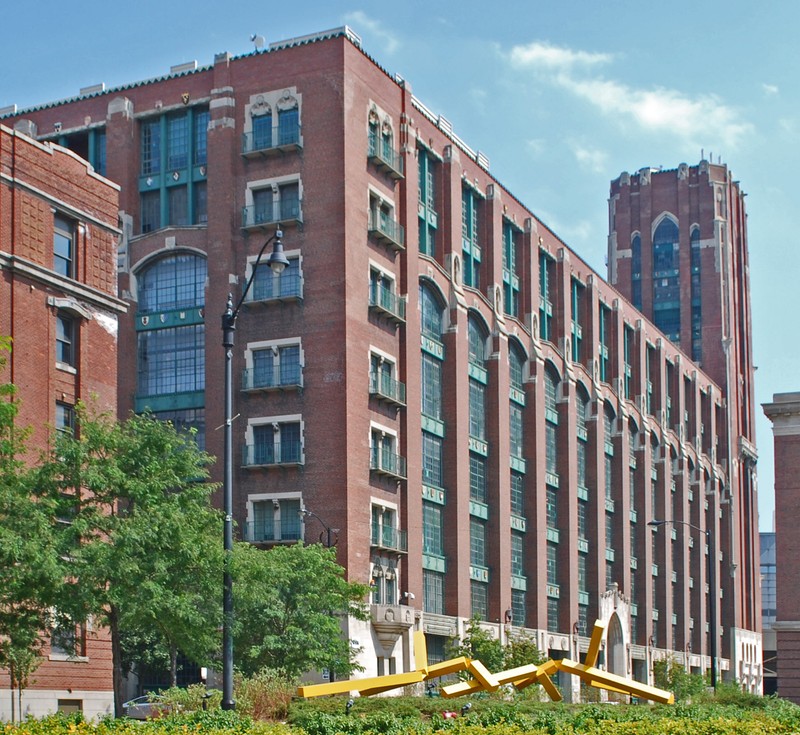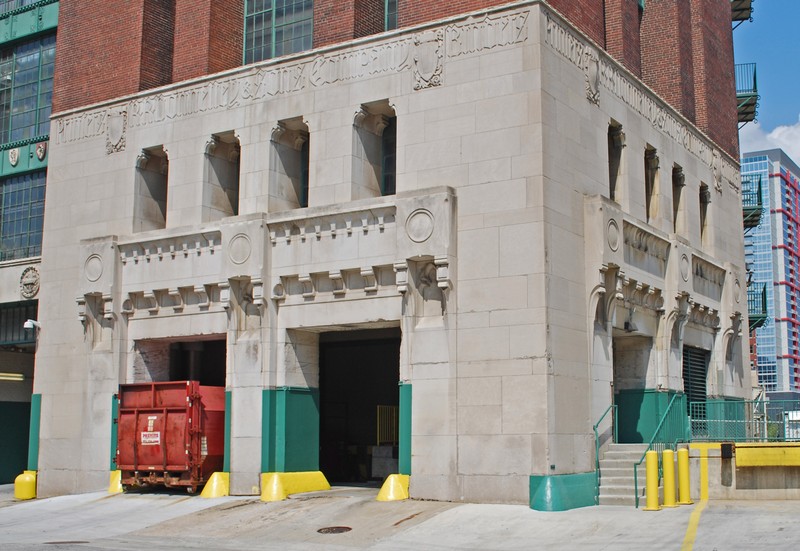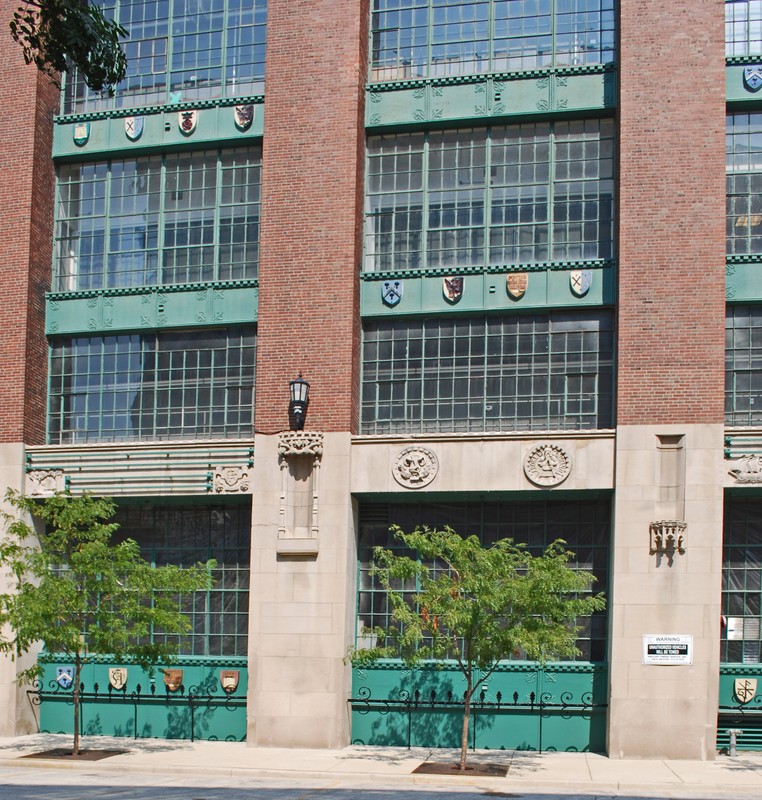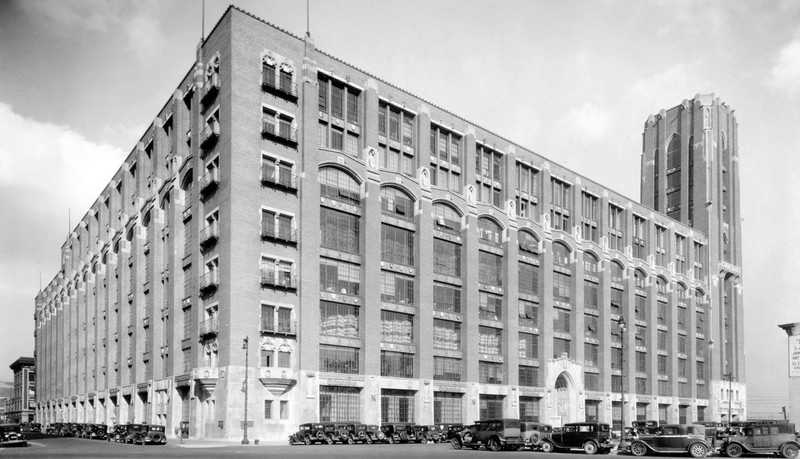R.R Donnelley Printing Plant (a.k.a The Calumet Plant, a.k.a Lakeside Plant)
Introduction
Text-to-speech Audio
Constructed between 1912 and 1929, this factory building served as the headquarters of printing giant R.R. Donnelley & Sons. At this location, the company designed and produced materials for numerous publications, such as Life Magazine. This is also the place where the Sears catalog was produced before being shipped throughout the nation. An incredibly strong building, architects designed the Plant with a fireproof design and 4,675 poured reinforced concrete columnns and an open-shell concrete floor, the type of support needed for several tons of paper and equipment used in printing. The building speaks to the volume of printing that occurred in Chicago during the early 20th century.
Images
Credit: Andrew Jameson - Own work, CC BY-SA 3.0, https://commons.wikimedia.org/w/index.php?curid=11331290

Credit: Andrew Jameson - Own work, CC BY-SA 3.0, https://commons.wikimedia.org/w/index.php?curid=11331303

By Andrew Jameson - Own work, CC BY-SA 3.0, https://commons.wikimedia.org/w/index.php?curid=11331280

Year unknown: https://chicagology.com/wp-content/themes/revolution-20/chicagoimages/rrdcalumet2.jpg

Backstory and Context
Text-to-speech Audio
The R.R Donnelley Printing Plant, a.k.a The Calumet Plant and a.k.a Lakeside Plant, serves as a monument to both the rise in consumerism in the early 20th century, notably before the Great Depression, as well as technological, or dot-com, revolution of the 1990s. Alongside New York, Chicago served as an epicenter for printing in the early 20th century with its most famous business owning the name, "Sears and Roebuck," who had its catalogues printed at R.R. Donnelley.
Before the introduction of large power presses around the time of the Civil War, almost all American towns included small printing houses. Chicago was not much different, but Chicago's massive population explosion coincided with more robust printing companies, so that by 1846 there were eight printing offices and four newspapers, a number that rose to 29 printing offices by the time of the Civil War. 1
After the war, Chicago's printing industry took-off, helped mightily by Chicago's existence as a railway stalwart, which eventually paved the way for R.R. Donnelley. Chicago was the home to 79 job printers and numerous, major newspapers, as well as seventeen binderies, 68 book stores, five printing supply and machinery manufacturers. Also, 20 new magazines go started in Chicago between 1860 and 1880. Industries such as Rand McNally and Sears & Roebuck arrived in the city during that time. 2
The Chicago Fire of 1871 resulted in a consolidation of new printing offices to be located on its near south side, where R.R. Donnelley arose, as well as what became "Printer's Row."
After the war, Chicago's printing industry took-off, helped mightily by Chicago's existence as a railway stalwart, which eventually paved the way for R.R. Donnelley. Chicago was the home to 79 job printers and numerous, major newspapers, as well as seventeen binderies, 68 book stores, five printing supply and machinery manufacturers. Also, 20 new magazines go started in Chicago between 1860 and 1880. Industries such as Rand McNally and Sears & Roebuck arrived in the city during that time. 2
The Chicago Fire of 1871 resulted in a consolidation of new printing offices to be located on its near south side, where R.R. Donnelley arose, as well as what became "Printer's Row."
Referred by the Chicago Tribune as "the most beautiful factory,' construction on the plant started in 1912 and, by its finish in 1929, comprised an entire city block. Built in multiple stages, the headquarters of printing giant R.R. Donnelley & Sons printed materials for numerous publications, such as Life Magazine and famous Sears catalog.3
This almost fortress-like structure included 4,675 steel-reinforced columnns and 10- to 12-inch-thick floors comprised of reinforcing bars, normally laid perpendicular, but were instead laid at various angles so that it could handle loads of 250 pounds per square foot. All told, the building was perfect for large equipment used in printing (and later, computers).4
This almost fortress-like structure included 4,675 steel-reinforced columnns and 10- to 12-inch-thick floors comprised of reinforcing bars, normally laid perpendicular, but were instead laid at various angles so that it could handle loads of 250 pounds per square foot. All told, the building was perfect for large equipment used in printing (and later, computers).4
With advances in technology and an eventual decline in the influence of the Sears brand, the building declined in significance and, eventually, quality; the City of Chicago condemned portions of the building in 1992, which forced Donnely to relocate to downtown Chicago. However, the "dot-com" boom provided life to the old building. In 1999, technological industrialists realized the potential of a building owning such strong bones. Investors purchased the building and renamed it the Lakeside Technology Center. The McClier firm, specialists in preservation and technology projects, resurrected the building and brought it up to code, as well as updated its electronics that are necessary for technology. 5
In just over a century, Chicago's swampy lands, once the home to Native Americans and, later, European trappers, were transformed into an industrial center. The R.R. Donnelley Plant is a physical reminder of the metamorphosis of a location that once relied on hunting and fishing to that of consumerism and capitalism. The building also represents Chicago's rise to prominence due to its those who chose to make Chicago a railroad hub, the nation's move to large-scale consumerism - as noted by catalogue printing, and its continued existence as a place of technology and support for those in the service industry, notably as it sits nearby the McCormick Place, the largest convention center in the United States.6
Sources
1 Paul F. Gehl, "Priting," The Encyclopedia of Chicago, (Chicago: Chicago Historical Society, 2005), http://www.encyclopedia.chicagohistory.org/pages/1010.html
2 Ibid.
3 Christine Houde, "Strange Marriage by the Lake," ProgressiveEngineer.com (Lewisburg, PA: Progressive Engineer, 2004), http://www.progressiveengineer.com/pewebbackissues2004/PEWeb%2048%20Mar%2004-2/Lakeside.htm
4 Ibid.;Chief Engineer, "The Most Powerful Building," The Chief Engineers Association of Chicagoland, chiefengineer.org, accessed Feb 10, 2017, http://chiefengineer.org/?p=2478.
5 Houde, "Strange Marriage by the Lake," 2004.
6 See, for example, the theis provided by William Cronon in his seminal work: William Cronon, Nature's Metropolis: Chicago and the Great West, (New York: W.W. Norton and Company, 1991).
2 Ibid.
3 Christine Houde, "Strange Marriage by the Lake," ProgressiveEngineer.com (Lewisburg, PA: Progressive Engineer, 2004), http://www.progressiveengineer.com/pewebbackissues2004/PEWeb%2048%20Mar%2004-2/Lakeside.htm
4 Ibid.;Chief Engineer, "The Most Powerful Building," The Chief Engineers Association of Chicagoland, chiefengineer.org, accessed Feb 10, 2017, http://chiefengineer.org/?p=2478.
5 Houde, "Strange Marriage by the Lake," 2004.
6 See, for example, the theis provided by William Cronon in his seminal work: William Cronon, Nature's Metropolis: Chicago and the Great West, (New York: W.W. Norton and Company, 1991).
